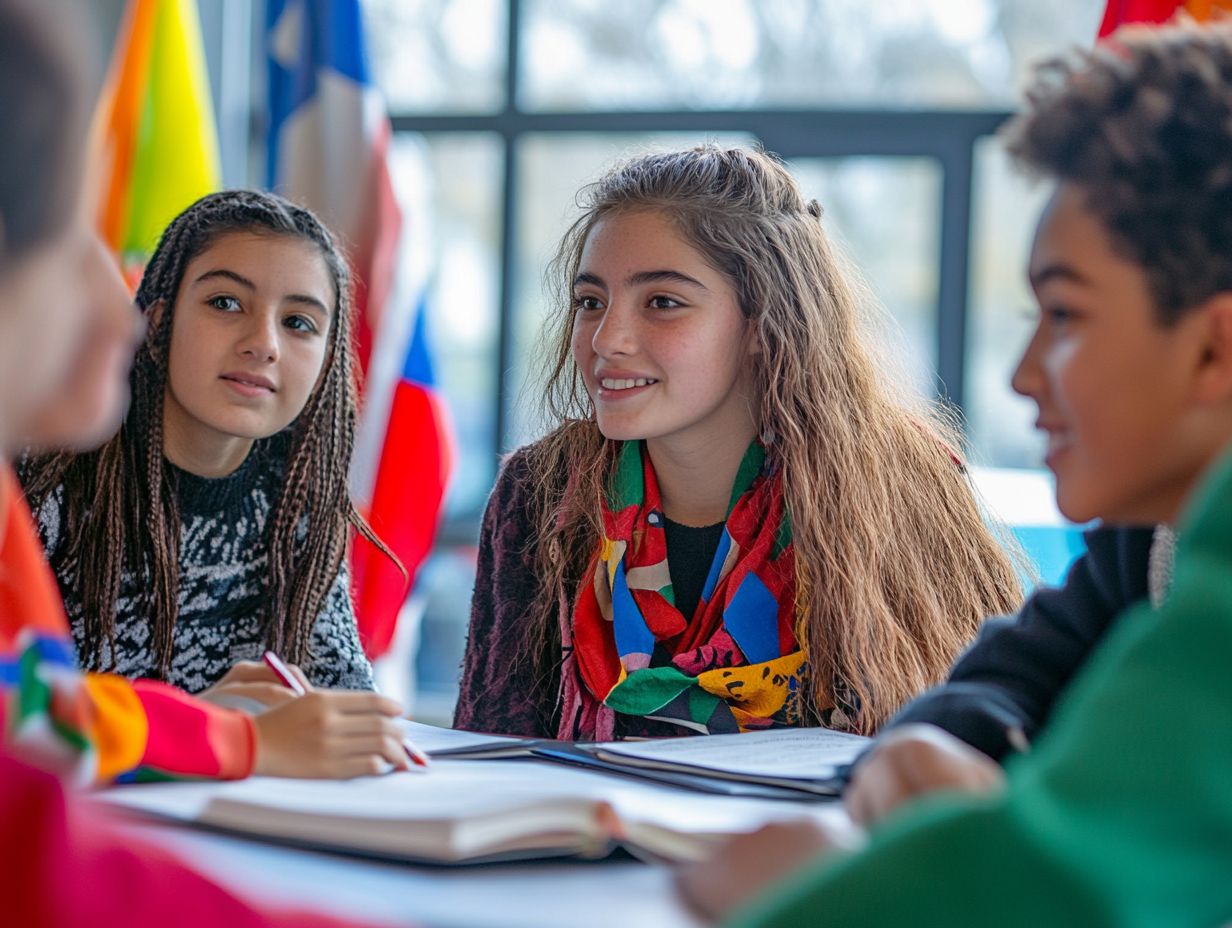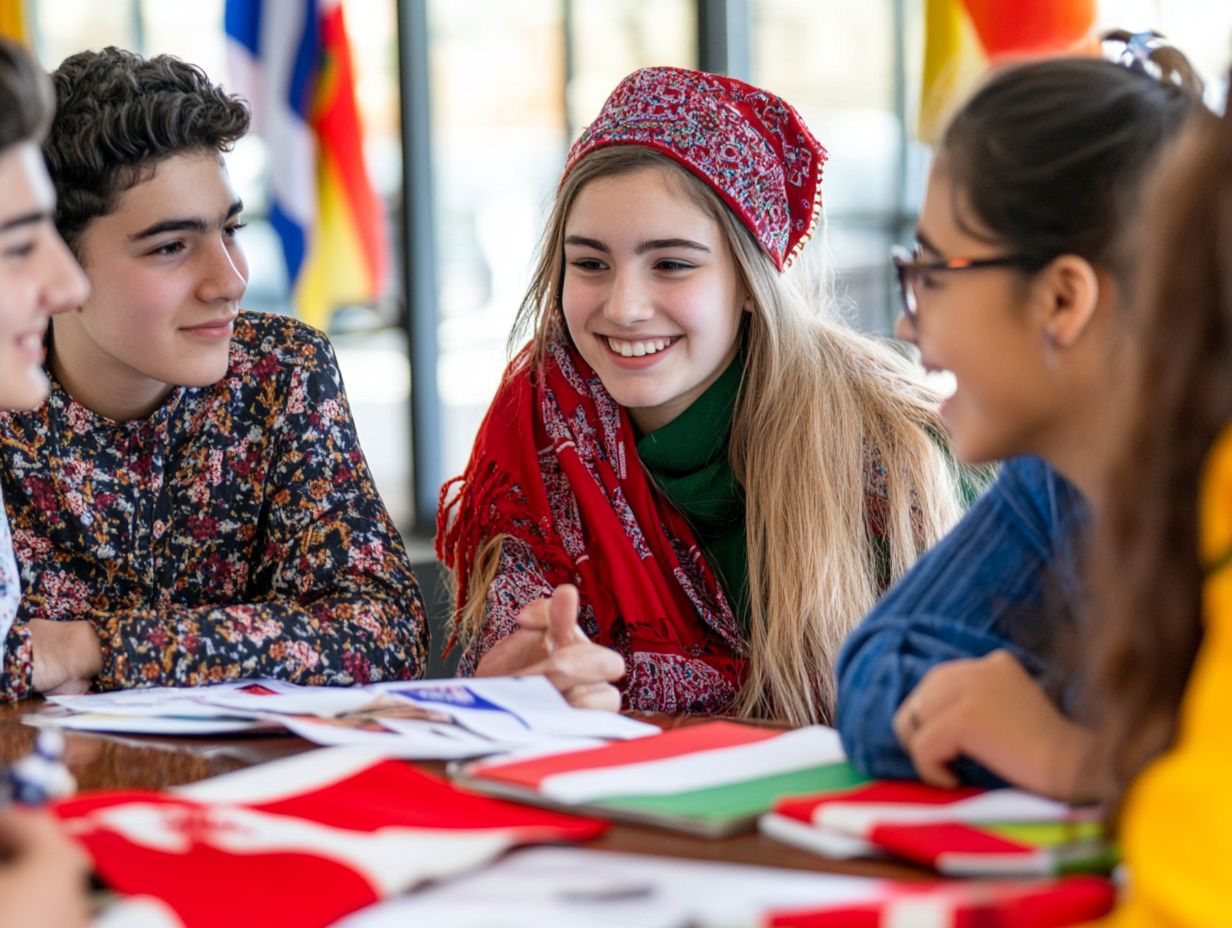5 Cultural Differences That Surprise Students
In today’s interconnected world, you encounter a vibrant tapestry of cultures that can enrich your educational experience. However, these differences can also challenge you.
From the subtleties of greetings and personal space to diverse eating customs and communication styles, these cultural differences can sometimes lead to misunderstandings or conflicts in the classroom.
This article delves into five key cultural differences that may catch you by surprise. It offers insights into how you can prepare for and embrace these diversities.
We will explore the advantages of a multicultural learning environment and provide strategies for educators to foster inclusivity. Together, you ll navigate this compelling landscape of cultural awareness and understanding.
Contents
- Key Takeaways:
- 1. Greetings and Personal Space
- 2. Eating Customs
- 3. Punctuality
- 4. Communication Styles
- 5. Attitudes Towards Authority
- Do These Differences Create Conflicts in the Classroom?
- How Can Students Prepare for These Cultural Differences?
- What Are Some Common Misunderstandings Due to Cultural Differences?
- How Can Students Learn to Embrace and Respect Different Cultures?
- What Are Some Benefits of Experiencing Different Cultures in the Classroom?
- How Can Teachers Create an Inclusive and Understanding Environment for Students from Different Cultures?
- Frequently Asked Questions
- What are the 5 cultural differences that surprise students?
- How does food differ across cultures?
- What are some surprising communication styles in different cultures?
- How Do Personal Space Boundaries Differ Between Cultures?
- What Social Norms Might Surprise Students?
- How Do Education Systems Differ Across Cultures?
Key Takeaways:

- Be mindful of personal space and greetings in different cultures to avoid misunderstandings.
- Understand and respect eating customs, such as using chopsticks or eating with your hands, to fully immerse yourself in a new culture.
- Arrive and communicate on time (punctuality), as it is valued differently in various cultures.
1. Greetings and Personal Space
In the USA, greetings and personal space are different from what you may expect. This can be a challenge as you adjust to American life.
Understanding these differences is crucial for successful social interactions, especially in informal encounters with strangers.
Many international students soon realize that expectations surrounding greetings and personal space vary dramatically based on their backgrounds. This can lead to confusion, but also opportunities for deeper connections.
For example, on the East Coast, a firm handshake is the go-to greeting. In contrast, the West Coast might have a more laid-back style think casual waves or even hugs among acquaintances.
These subtleties in greetings can catch newcomers off guard, especially those from cultures like Italy or Spain, where close physical proximity is the norm.
On the flip side, German culture emphasizes a more reserved approach to personal space, creating culture shock for exchange students arriving in the States.
By taking time to understand these varying norms, you can ease your transition and cultivate richer, more meaningful relationships.
2. Eating Customs
Get ready for a delightful array of surprises in American eating customs! These unique food experiences may differ significantly from what you re accustomed to back home.
From family game nights featuring traditional American fare to casual dining at places like BestBuy or Walmart, every meal reveals cultural influences that shape American life.
These meals highlight the importance of gathering around the table, where families bond and share stories that transcend generations.
Each region of the country adds its own flavors; for instance, Southern hospitality often means hearty plates of fried chicken and biscuits, while the Northeast showcases clam chowder and fresh seafood.
Cultural etiquette also varies. Many Americans place great importance on saying “thank you” and engaging in light conversation during meals. This might feel like a learning curve for you.
One international student recalled her first Thanksgiving dinner. She felt a mix of nerves and excitement, overwhelmed by an array of dishes from sweet potato pie to turkey. Yet, she was captivated by the warm laughter and inviting atmosphere that surrounded her.
3. Punctuality
In American culture, punctuality is often seen as a hallmark of respect and responsibility. This value can be quite surprising for exchange students coming from different backgrounds where time is viewed more flexibly. You’ll notice that being on time influences many aspects of American life, including school spirit and the expectations set by teachers.
This emphasis can lead to surprising differences for international students adjusting to their new teenage experiences. Take Colombia, for example, where social gatherings often start long after the stated time. There, schedules tend to be more relaxed, prioritizing relationships over strict timeliness.
On the other hand, in Germany, punctuality is almost a sacred principle, synonymous with professionalism and dedication. These contrasting perspectives can create misunderstandings; an American might feel slighted by a late arrival, while someone from Colombia could see their punctuality as unnecessarily rigid.
Mastering these cultural differences can be exciting! It s all about finding a balance embracing American social norms while also honoring your own cultural roots.
4. Communication Styles

Communication styles in the USA often favor directness and clarity, offering a refreshing shift for exchange students who are used to more indirect approaches. In American culture, informal interactions are the norm, fostering friendship-based relationships that might feel overly casual or even perplexing for those coming from different backgrounds.
The cultural emphasis on positivity infuses social exchanges, creating a vibrant atmosphere that can make the adjustment to a new environment exciting yet challenging.
You ll notice that verbal and non-verbal communication varies significantly across cultures, like those in Spain or Guatemala. For example, in Spain, conversations tend to be lively, filled with expressive gestures and passionate tones, where eye contact signifies engagement and warmth. In contrast, Guatemala often embraces a softer, more reserved approach, highlighting respect and humility.
By paying attention to these subtle differences, you can enhance your experience. Maintaining eye contact with peers from Spain can strengthen connections, while adopting a more subdued demeanor might resonate more with Guatemalan friends. Recognizing these differences now will supercharge your interactions and help you build meaningful relationships while you re abroad.
5. Attitudes Towards Authority
Attitudes toward authority figures, especially American teachers, can vary significantly from those in other countries, presenting unique challenges for you as an exchange student navigating the educational landscape in the USA. You might find that the informal interactions and open dialogue encouraged in American classrooms stand in stark contrast to the more hierarchical structures you re used to, leading to both enlightening benefits and surprising culture shocks.
For example, in Italy, you may notice that students show a certain level of deference toward their teachers, viewing them as authoritative figures whose expertise is to be respected. On the other hand, in Germany, students are likely to question authority more freely, reflecting a culture that highly values critical thinking and dialogue.
These differences can greatly shape classroom behavior, where Italian students tend to be more reserved, while their German peers actively engage in discussions. To adapt, you can benefit from observing the classroom dynamics around you.
Gradually integrating into conversations by building your confidence and seeking clarification when needed can help you bridge cultural gaps and contribute to a more inclusive learning environment.
Do These Differences Create Conflicts in the Classroom?
The cultural differences between exchange students and their American peers can create conflicts in classroom settings, often leading to misunderstandings and miscommunications. These conflicts typically arise from varying foreign views on social norms, authority, and how people communicate and relate to each other. This results in different levels of culture shock as international students navigate their new educational environment.
For instance, while some students may thrive in lively debates during lectures, their American counterparts might prefer a more structured and formal approach to class discussions. Attitudes toward assignments can also vary significantly. Some students may see collaborative projects as essential for relationship-building, while others prioritize individual work due to cultural values that emphasize personal achievement.
These differences show why fostering open dialogue is important. Encouraging genuine exchanges of ideas helps bridge cultural gaps, ultimately promoting mutual respect and understanding within the classroom.
How Can Students Prepare for These Cultural Differences?
Preparing for cultural differences is crucial for you as an exchange student. It ensures a smoother transition into American life, minimizing confusion and enhancing your experience. Dive into community support through orientation programs or cultural exchange workshops to gain valuable insights into American customs and social interactions.
Proactively research the everyday lives and customs of Americans. Explore online resources, books, or documentaries to better understand values like individualism and the informality that often characterizes communication.
Joining pre-departure orientations lays a solid foundation for understanding cultural aspects and offers a platform to connect with other students facing similar challenges. Forming bonds with local communities or seeking mentors can greatly enhance your understanding, fostering an environment of adaptability and open-mindedness essential for thriving in a new culture.
What Are Some Common Misunderstandings Due to Cultural Differences?

Common misunderstandings stemming from cultural differences can significantly influence your social interactions as an exchange student, often leading to unintended conflicts or awkward moments. Misinterpreting gestures, humor, or conversational norms may hinder your ability to form friendship-based relationships. Therefore, you need to navigate these cultural complexities with awareness and patience.
For example, what you might view as a friendly gesture could be seen as intrusive in another culture. Humor, too, can create confusion; sarcasm, for instance, often struggles to translate across different cultural contexts. Eye contact, which is usually a sign of confidence in American culture, might feel uncomfortable for those from backgrounds where such directness is less common.
To bridge these gaps, engage in open dialogue by asking clarifying questions about intent and meaning. Pay attention to your peers’ body language to better interpret social cues. Join social events to feel more included and learn about American social customs.
How Can Students Learn to Embrace and Respect Different Cultures?
Embracing and respecting different cultures is an essential skill for you as an exchange student. It fosters a positive environment that nurtures mutual understanding and appreciation. By engaging with your American peers, you can broaden your perspective on cultural differences. This enriches your overall experience and contributes to a more inclusive community.
To cultivate this understanding, immerse yourself in cultural events like festivals and workshops. These provide firsthand exposure to diverse traditions and practices. Joining international-themed clubs not only encourages mingling with others but also opens the door to deeper discussions about heritage and identity.
Engaging in community service allows you to connect with locals while making a meaningful impact. This promotes a spirit of empathy and collaboration. Your curiosity and openness will play pivotal roles in these interactions. They will help you build genuine relationships that transcend cultural boundaries.
What Are Some Benefits of Experiencing Different Cultures in the Classroom?
Experiencing different cultures in the classroom offers countless benefits. It enriches your educational journey and deepens your understanding of global perspectives. When exposed to diverse backgrounds, you can enhance your creativity, foster critical thinking, and cultivate empathy. These cultural encounters become invaluable parts of your learning experience.
As you interact with others, you ll likely see a significant improvement in your social skills. You will learn to navigate differences and communicate effectively. For instance, one exchange student from Brazil shared how engaging with classmates helped her break out of her shell. She said, “I learned to express myself confidently, and it changed my perspective on teamwork.”
American students resonate with this experience, too. They appreciate the broad worldviews gained through discussions and collaborative projects. This teamwork strengthens friendships and fosters a rich learning environment where everyone benefits from shared knowledge and cultural insights.
How Can Teachers Create an Inclusive and Understanding Environment for Students from Different Cultures?
Creating an inclusive and understanding environment for students from diverse cultures is essential for teachers. If you aim to foster a supportive educational atmosphere, promote collaboration and respect. Implement teaching methods that respect different cultures and engage community support. This will help bridge cultural gaps and provide a welcoming space where exchange students can thrive.
To achieve this, actively seek out and integrate diverse materials that reflect the rich backgrounds of your students. This ensures that everyone feels represented in the curriculum. Facilitating open dialogues about culture encourages your students to share their experiences. This fosters a sense of belonging and nurtures empathy among peers.
Collaborative projects that group students from varied backgrounds allow them to learn from each other. This also helps dismantle stereotypes. In this way, you play a crucial role in modeling respect and curiosity towards different cultural backgrounds. You set a powerful example for your students to follow.
Frequently Asked Questions

What are the 5 cultural differences that surprise students?
- Food
- Communication styles
- Personal space
- Social norms
- Education systems
How does food differ across cultures?
Food is a major cultural difference that many students notice. Different cultures have their own unique dishes and ingredients. For example, while Western cultures may eat with utensils, Asian cultures may use chopsticks or even their hands.
What are some surprising communication styles in different cultures?
Communication styles can vary greatly across cultures. In Western cultures, they may be direct and assertive, while in Eastern cultures, they can be more indirect and polite. This variation can lead to misunderstandings for students studying abroad.
How Do Personal Space Boundaries Differ Between Cultures?
Personal space changes from culture to culture. In some places, people stand close while talking; in others, a larger distance is preferred. This can be a challenge for students to get used to.
What Social Norms Might Surprise Students?
Social norms are the accepted ways of behaving in a society. For instance, in some cultures, making eye contact shows respect, while in others, it can seem rude. Students should explore these norms before visiting new places.
How Do Education Systems Differ Across Cultures?
Education systems vary widely around the world. Some countries have structured and formal systems, while others offer more relaxed and hands-on learning. This difference can be a big adjustment for students studying abroad.





